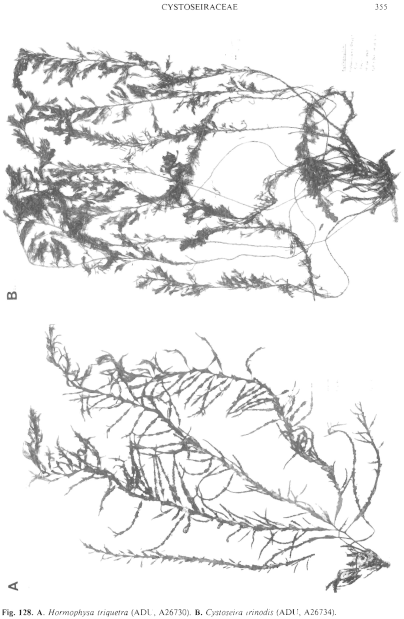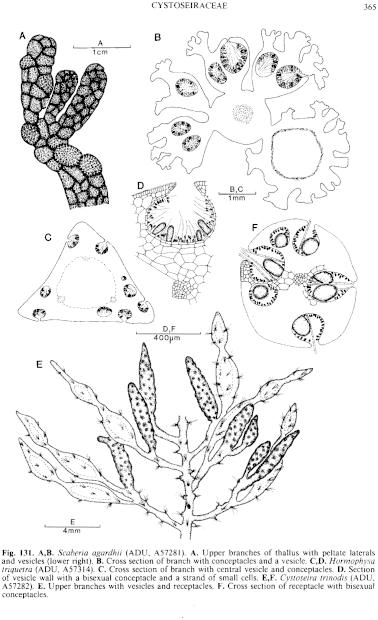|
|
|
|
|
|||||||||||
|
Electronic Flora of South Australia Species Fact Sheet
Phylum Phaeophyta – Order Fucales – Family Cystoseiraceae
Selected citations: Allender & Smith 1978: 61, figs 1–3. Mairh & Krishnamurthy 1970: 38, figs 1–47. Papenfuss 1967: 42. Womersley 1967: 255.
Synonyms
Cystoseira triquetra C. Agardh 1820: 61.
Fucus triqueter Linnaeus. Turner 1808: 72, pl. 34.
Thallus (Fig. 128A) medium to dark brown, (10–) 20–40 cm long, with a short, terete, stipe bearing few to many primary branches, each irregularly tristichously and spirally branched from the rhachis, with most laterals of more-or-less limited growth. Holdfast discoid-conical, 5–10 mm across; epilithic. Primary branches with triquetrously arranged wings, each 0.5–2 (–3) cm long and 1–5 (–7) mm broad above before terminating, with vesicles (Fig. 13IC) developing centrally within the medulla in the upper part of the branches; lower part of branches usually denuded; vesicles elongate, 5–10 mm long and 2–4 mm in diameter. Lesser branches (1–) 2–6 (–10) cm long, compressed to triquetrous, with marginal rows of short teeth 0.5–2 (–3) mm long, cryptostomata numerous, scattered. Growth from a single, three-sided, apical cell in an apical depression. Structure of a central medulla of compact, elongate, cells and an extensive cortex of isodiametric cells decreasing in size to the surface phaeoplastic meristoderm; medulla absent or slight in the wings; vesicles with longitudinal strands of smaller cells opposite the wings (Fig. 131C).
Reproduction: Thalli monoecious. Conceptacles (Fig. 131C,D) bisexual, scattered over the thallus without distinctive receptacles; oogonia sessile, ovoid and broad based, 80–120 µm long and 35–60 µm in diameter; antheridia sessile or on short, branched, paraphyses, elongate-ovoid, 20–30 µm long and 8–12 µ in diameter; simple paraphyses also present.
Type from India(?) (see Papenfuss 1967, p. 42).
Selected specimens: Port Broughton, S. Aust., in outer channel (Womersley, 1.xii.1963; ADU, A27036) and near boat ramp, drift (Reimers, 6.xii.1986; ADU, A57314). Fisherman Bay, Port Broughton, S. Aust., drift (Womersley, 10.ix.1963; ADU, A26730-"Marine Algae of southern Australia" No. 56, and 23.viii.1967; ADU, A31801). Port Augusta, S. Aust., drift (Womersley, 31.xii.1950; ADU, A13825).
Distribution: Throughout the Indo-Pacific tropics and subtropics, extending into warm temperate seas. In Australia, extending south on the west coast to Point Peron and the Peel Inlet (Allender & Smith 1978) and on the east coast to Port Stephens, N.S.W. (May 1939, p. 205, as Hormosira articulata).
In southern Australia, known from the Port Broughton region and Port Augusta in northern Spencer Gulf, S. Aust.
Taxonomic notes: H. triquetra is highly variable in form (Allender & Smith 1978), but the Spencer Gulf specimens are well developed and typical of the species; they may be a relict population.
Womersley (1967, p. 256) suggested that Fucus nodularius Mertens (1819, p. 189, pl. 15) may be a denuded form of H. triquetra, but further specimens from Shark Bay, W. Aust. indicate that the former is an independent species, the type locality of which is "Nov. Holl. occid." (which may be the Shark Bay region).
References:
AGARDH, C.A. (1820). Species Algarum. Vol. 1, Part 1, Fucoideae, pp. 1–168. (Lund.)
ALLENDER, B.M. & SMITH, G.G. (1978). Thallus variation in Hormophysa triquetra (C. Ag.) Kuetz. (Fucales, Phaeophyta) in oceanic and estuarine habitats. J. R. Soc. W. Aust. 60, 61–64.
KÜTZING, F.T. (1843). Phycologia generalis. (Leipzig.)
MAIRH, P. & KRISHNAMURTHY, V. (1970). Some observations on the morphology and development of Hormophysa triquetra (C. Ag.) Kütz. Bot. Mar. 13, 38–41.
MAY, V. (1939). A key to the marine algae of New South Wales. Part. II. Melanophyceae (Phaeophyceae). Proc. Linn. Soc. N.S.W. 64, 191–215.
MERTENS, M. (1819). Sur plusieurs espêces de Fucus, nouvelles ou peu connues, observées dans la collection du Muséum. Mem. Mus. Natl Hist. Nat., Paris 5, 172–90, Plates 13–15.
PAPENFUSS, G.F. (1967). The history, morphology and taxonomy of Hormophysa (Fucales: Cystoseiraceae). Phytomorphology 17, 42–47.
TURNER, D. (1808). Fuci sive Plantarum Fucorum Generi a Botanicis Ascriptarum Icones Descriptiones et Historia. Vol. 1, pp. 1–164, Plates 1–71. (London.)
WOMERSLEY, H.B.S. (1967). A critical survey of the marine algae of southern Australia. II. Phaeophyta. Aust. J. Bot. 15, 189–270.
The Marine Benthic Flora of Southern Australia Part II complete list of references.
Publication:
Womersley, H.B.S. (14 December, 1987)
The Marine Benthic Flora of Southern Australia
Part II
©Board of the Botanic Gardens and State Herbarium, Government of South Australia
Illustrations in Womersley Part II, 1997: FIGS 128A, 131C,D.

Figure 128 enlarge
Fig. 128. A. Hormophysa triquetra (ADU, A26730). B. Cystoseira trinodis (ADU, A26734).

Figure 131 enlarge
Fig. 131. A,B. Scaberia agardhii (ADU, A57281). A. Upper branches of thallus with peltate laterals and vesicles (lower right). B. Cross section of branch with conceptacles and a vesicle. C,D. Hormophysa triquetra (ADU, A57314). C. Cross section of branch with central vesicle and conceptacles. D. Section of vesicle wall with a bisexual conceptacle and a strand of small cells. E,F. Cystoseira trinodis (ADU, A57282). E. Upper branches with vesicles and receptacles. F. Cross section of receptacle with bisexual conceptacles.

|
Email Contact: State Herbarium of South Australia |

|